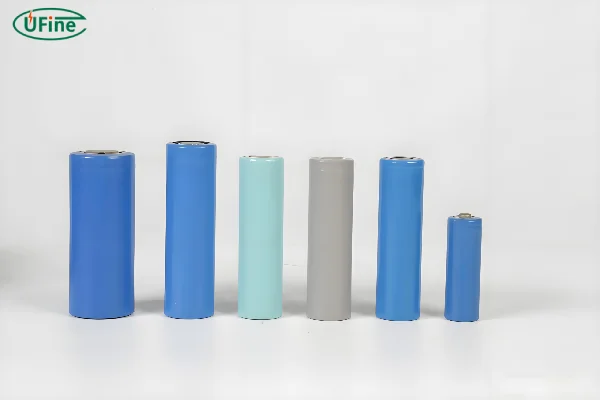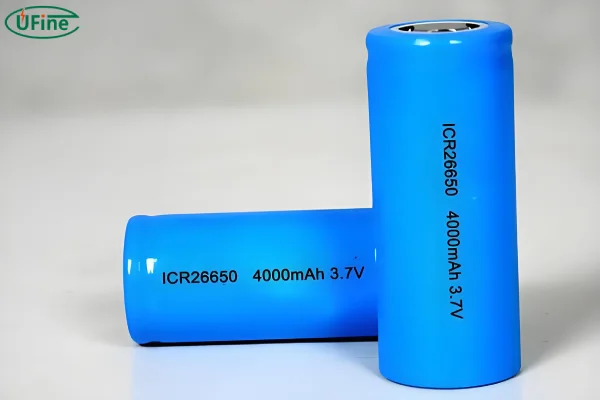When it comes to powering your high-drain devices, the 26650 lithium battery stands out as a reliable choice. Known for its robust capacity and long lifespan, it’s popular in various applications. In this detailed guide, we’ll explore every aspect of the 26650 battery. From its size and capacity to how it stacks up against other batteries, we’ve got you covered. So, let’s dive in and learn why the 26650 might just be the perfect battery for your needs.
Part 1. Size
The 26650 lithium battery is named for its dimensions: 26mm in diameter and 65mm in length. This size makes it larger than some other cylindrical batteries like the 18650. The additional space allows for more energy storage, which is crucial for devices that require a lot of power. While the size might seem bulky for smaller gadgets, it’s perfect for applications where power matters more than compactness. Whether it’s for a flashlight or an electric bike, the 26650’s size makes it a powerhouse.
Part 2. Voltage
Voltage is a critical factor when selecting a battery, and the 26650 doesn’t disappoint. It typically has a nominal voltage of 3.7V. This standard voltage is common among lithium batteries, making it compatible with various devices. The stability of this voltage ensures consistent performance, which is vital for devices that need reliable power over long periods. If you’re using multiple cells to create a higher voltage system, the 26650 can easily be configured in series.
Part 3. Weight
Weighing in at around 90 grams, the 26650 lithium battery is heavier than its smaller counterparts. This extra weight is a trade-off for its higher capacity and longer runtime. For portable devices, this might seem like a downside, but for stationary or larger equipment, the weight is often negligible. The added mass is a small price to pay for the extended energy and reliability it provides. So, if your device can handle a bit of extra weight, the 26650 is worth considering.
Part 4. Maximum Capacity
One of the standout features of the 26650 lithium battery is its impressive capacity. On the market, these batteries can reach up to 5500mAh. This high capacity means longer usage times between charges, which is perfect for devices that require sustained power. Whether you’re going on a long hike or need a dependable battery for your power tools, the 26650’s capacity ensures you’ll have the energy you need. It’s all about convenience and efficiency, making it a top choice for power-hungry gadgets.
Part 5. Key features of 26650 lithium battery
Let’s take a closer look at some key features that make the 26650 lithium battery a popular option:
- High Capacity: As mentioned, up to 5500mAh, providing extended use without frequent recharging.
- Long Lifespan: Capable of enduring numerous charge cycles, making it cost-effective over time.
- Stable Voltage: Delivers consistent performance, crucial for maintaining device functionality.
- Safety Features: Equipped with protection against overcharging and overheating, ensuring safe operation.
- Environmentally Friendly: Contains no toxic metals, making it a greener choice compared to some other battery types.
These features highlight why the 26650 is a reliable and efficient power source for various applications.
Part 6. 26650 lithium battery vs. 18650 vs. 21700

When it comes to cylindrical batteries, there are several options to consider. Let’s compare the 26650 with the 18650 and 21700 to see how they stack up:
Comparison Table
| Feature | 26650 | 18650 | 21700 |
|---|---|---|---|
| Size | 26x65mm | 18x65mm | 21x70mm |
| Voltage | 3.7V | 3.7V | 3.7V |
| Capacity | Up to 5500mAh | Up to 3600mAh | Up to 5000mAh |
| Weight | ~90g | ~50g | ~70g |
| Lifespan | ~500 cycles | ~300 cycles | ~400 cycles |
| Cost | Moderate | Lower | Higher |
| Applications | High-drain devices | Portable electronics | Electric vehicles |
Detailed Comparison
-
Size: The 26650 is the largest, providing more capacity but requiring more space. If your device can accommodate it, this battery is a powerhouse.
-
Voltage: All three batteries maintain a consistent 3.7V, making them versatile across different devices.
-
Capacity: With up to 5500mAh, the 26650 offers the highest capacity, meaning longer runtime and fewer charges.
-
Weight: Heaviest among the three, the 26650’s weight is balanced by its high energy output.
-
Lifespan: It boasts around 500 cycles, giving it an edge over the 18650 in terms of longevity.
-
Cost: While more expensive than the 18650, the 26650 offers more value with its capacity and lifespan.
-
Applications: Ideal for high-drain devices, whereas 18650 is common in smaller electronics, and 21700 is often used in electric vehicles.
Difference Between 18650, 26650, and 21700 Batteries
Part 7. What device uses 26650 lithium battery?
- Flashlights: Provides bright, long-lasting illumination, perfect for outdoor adventures or emergency use.
- Power Tools: Delivers the necessary power for heavy-duty tasks, ensuring efficiency and reliability.
- Electric Bikes: Offers extended rides with fewer interruptions, making it ideal for long-distance travel.
- Portable Speakers: Ensures hours of uninterrupted music, perfect for parties or outdoor gatherings.
- RC Vehicles: Powers high-performance models for longer, more exciting runs.
These applications demonstrate the battery’s adaptability and effectiveness across different fields.
Part 8. Is 26650 lithium battery the best cylindrical battery?
The 26650 lithium battery is undoubtedly a strong contender in the world of cylindrical batteries. Its high capacity and long lifespan make it a favorite for many high-drain applications. However, whether it’s the best choice depends on your specific needs. If your device requires a lot of power and can handle the size and weight, the 26650 is a fantastic option. But for smaller devices, the 18650 might be more suitable due to its compactness and lower cost. Ultimately, the best battery is the one that fits your device’s requirements and your personal preferences.
Part 9. Which cylindrical battery do I need for my device?
Choosing the right cylindrical battery can be a bit overwhelming, but here are some tips to help you decide:
-
Device Requirements: Always check your device’s specifications to ensure compatibility with the battery’s voltage and capacity.
-
Size Constraints: Make sure the battery fits within the designated compartment of your device.
-
Usage Patterns: Consider how often you use the device and how much power it consumes. A higher capacity battery might be beneficial for frequent use.
-
Budget: Balance the cost with performance and longevity. While some batteries might be more expensive initially, they could save you money in the long run through lower replacement costs.
By assessing these factors, you can determine whether a 26650 lithium battery or another type is the best fit for your device. Understanding your specific needs will guide you to the most suitable choice, ensuring optimal performance and satisfaction.
In conclusion, the 26650 lithium battery offers numerous advantages, from its high capacity to its long lifespan. Whether it’s the best choice for you depends on your individual needs and the demands of your devices. By understanding its features and comparing it with other options, you can make an informed decision that will keep your gadgets running smoothly.
Related Tags:
More Articles

How to Choose the Best Floor Scrubber Battery for Commercial Cleaning?
Selecting the ideal floor scrubber battery ensures a long runtime, rapid charging, and minimal maintenance for efficient commercial cleaning operations.
Battery for Blower vs Battery for Leaf Vacuum: Which One Should You Choose?
Battery for blower vs leaf vacuum—learn the key differences in power, fit, and runtime to choose the right battery for your outdoor tool needs.
How to Choose the Right Battery for Blower?
Choosing the right blower battery? Consider voltage, capacity, chemistry & usage. This guide helps match the best battery for peak performance.
How to Choose the Best Insulated Battery Box for Lithium Batteries?
Choosing the Best Insulated Battery Box for Lithium Batteries? Discover key factors such as size, material, and safety for optimal protection and performance.
7 Critical Elements on a Lithium Battery Shipping Label
What must be on a lithium battery shipping label? Learn 7 key elements to ensure safety, legal compliance, and correct handling across all transport modes.




